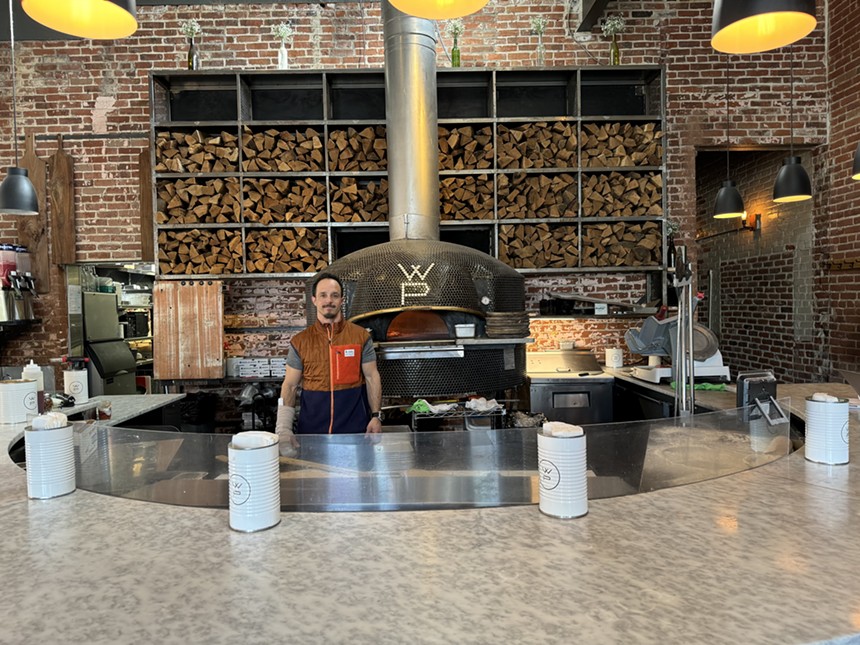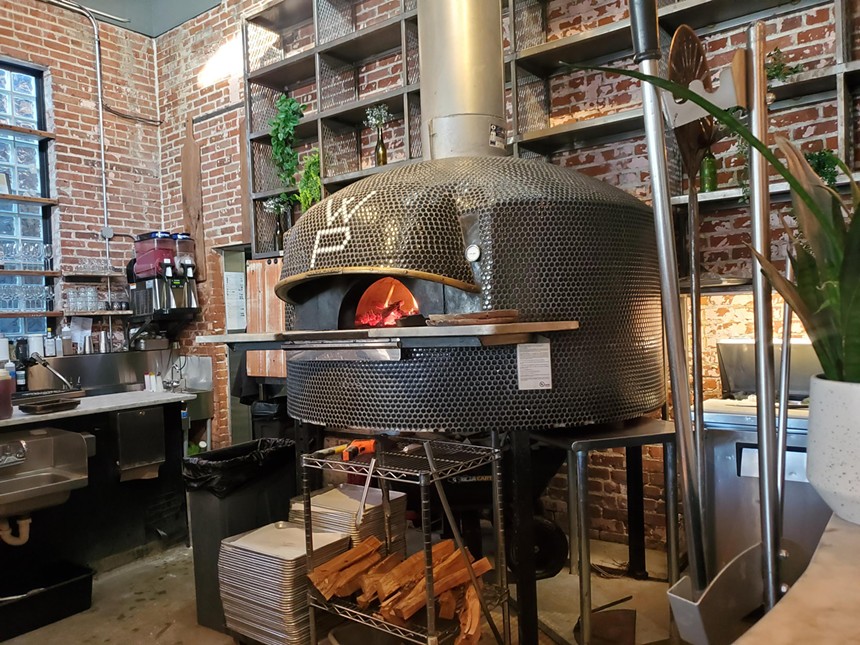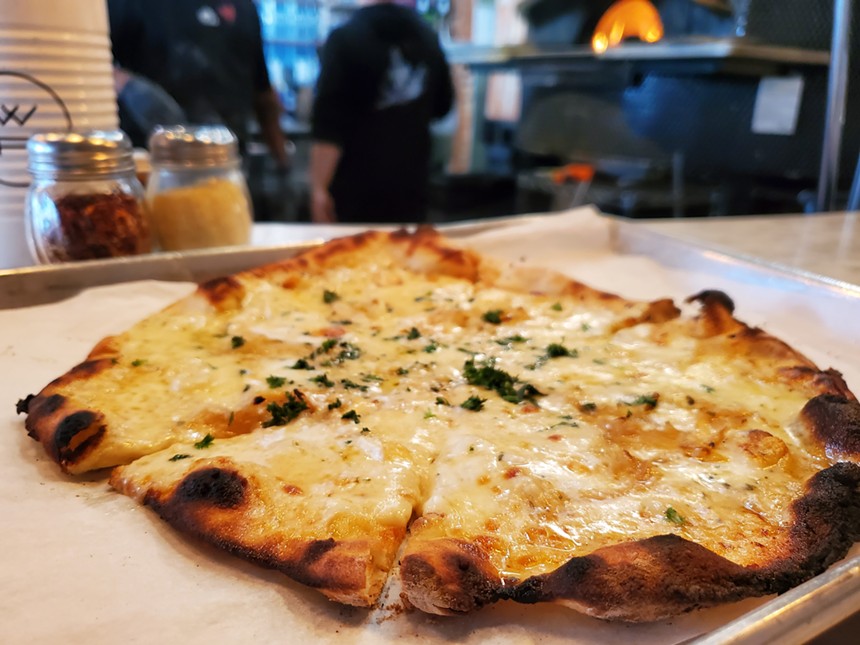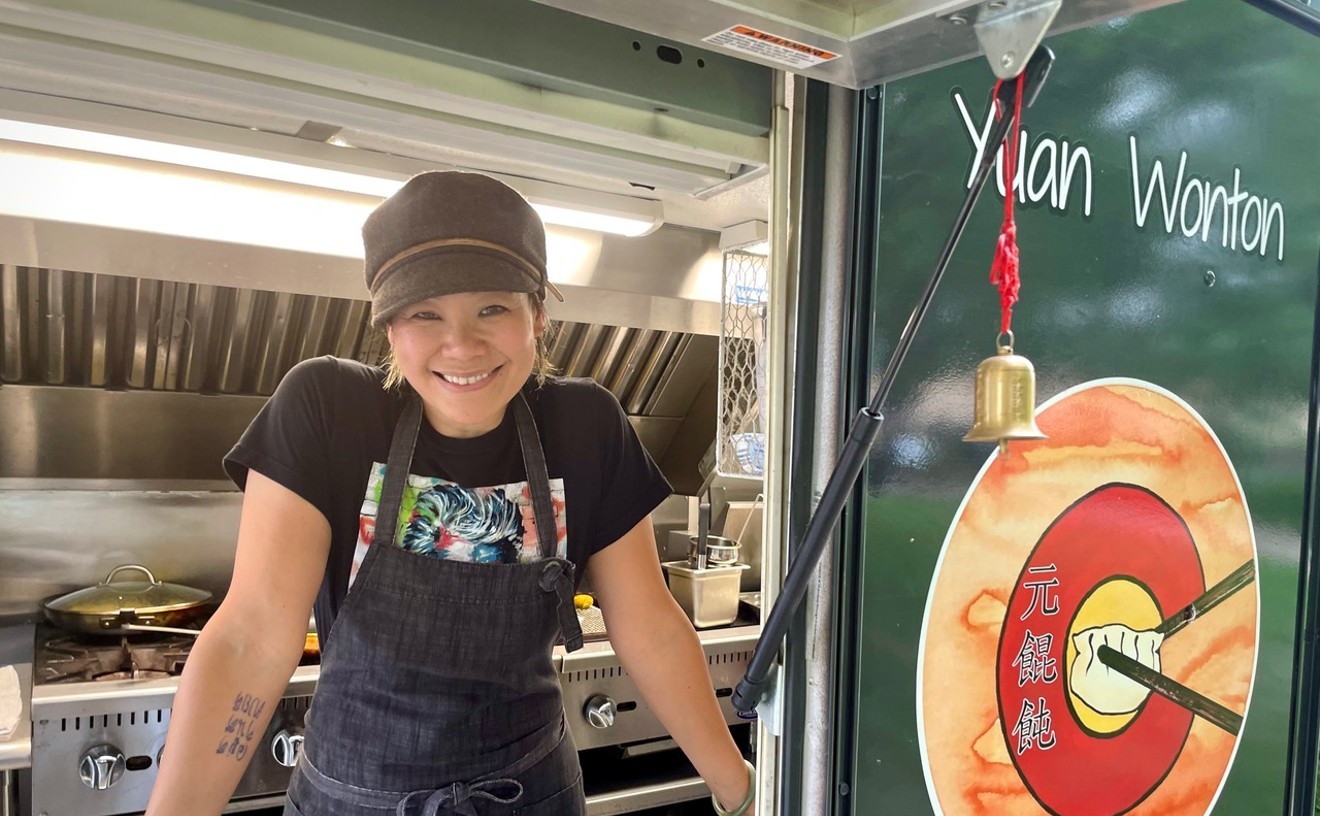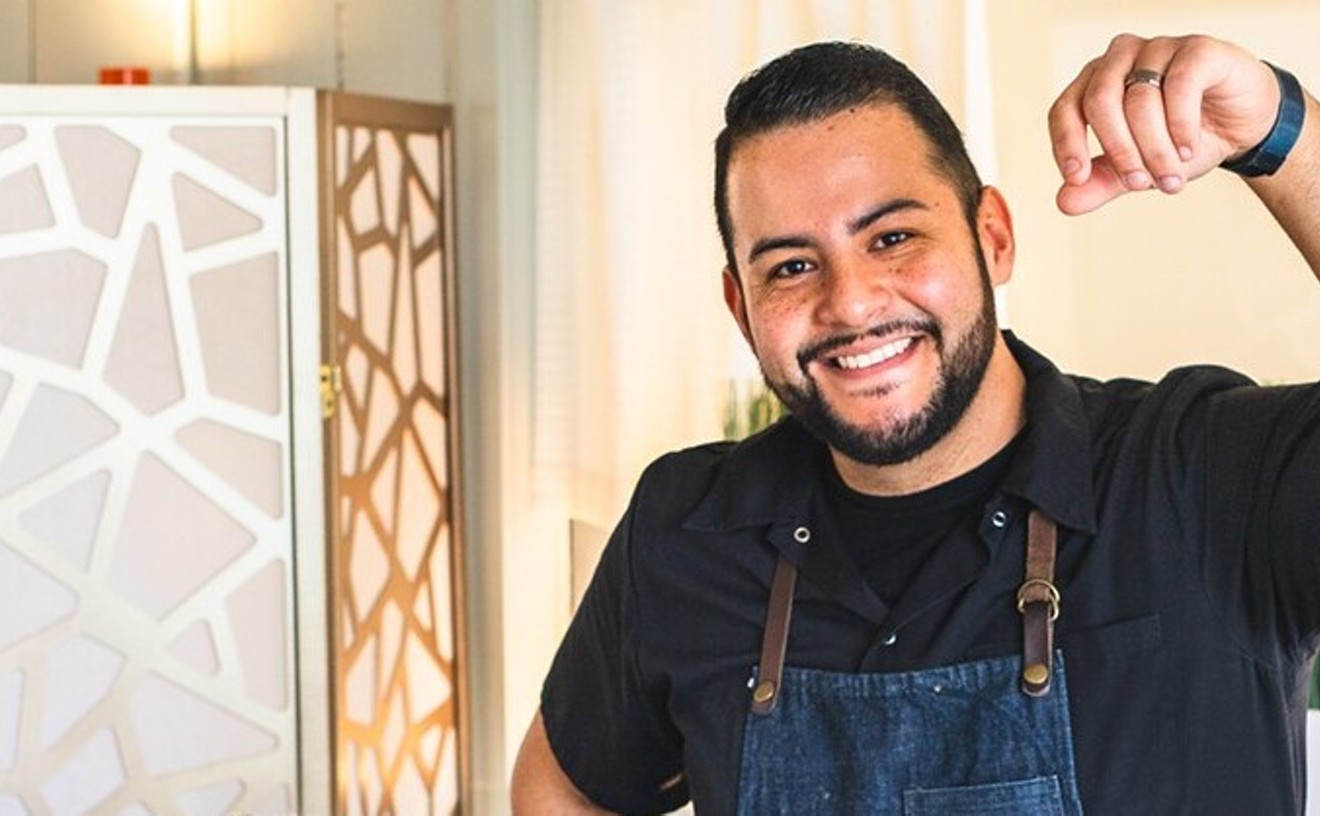“It’s the pursuit of perfection. I wouldn’t say it’s perfect — it’s mine and many chefs' obsession," says Kristopher Wallenta. He's talking about pizza, a dish he has spent the majority of his adult life perfecting both before and after opening White Pie in 2017 with his brother, Jason, and his brother’s wife, Riley O'Brien.
Last year, the pizzeria at 1702 Humboldt Street was our Best of Denver pick for Best Pizzeria — so what makes its pies so special?
With an Italian father and a Mexican mother, food was always a big part of the brothers' lives when they were growing up in New Haven, Connecticut. Some of Wallenta's earliest memories are of helping his mother make pancakes and frying eggplant for his father’s eggplant parmesan. “We didn’t go out a lot as kids to restaurants, but my dad would take us every weekend to our pizza mecca, Sally’s in New Haven," Kristopher says. “To me, the greatest pizzaiolo that ever lived was Sal Consiglio, the owner of Sally's."
He went to Colorado State University for journalism and public relations, then traveled to Mexico and spent the summer working at his aunt and uncle's restaurant there, an experience that convinced him to abandon the idea of a desk job and pursue his passion for food.
After attending the French Culinary Institute in New York City, Wallenta went back to Cozumel to work at his relatives' eatery. Five years later, he opened his own restaurant there in 2008, then a second with his brother in 2010. He was cooking Mexican food, but pizza was always on his mind.
Wallenta commissioned builders to install a Neapolitan-style refractory brick dome oven at his Cozumel eatery so he could continuously practice and test his recipes and techniques. “For months and months and months, my brother and I would three, four times a week make our dough, make our pizzas, and just test the oven, test the ingredients, test the techniques, the dough, the hydration level, the cook times, the temperature of the oven — all these things,” he recalls.
It was his brother who convinced him to bring a restaurant to Denver. The original plan was to open a pizzeria, but “we decided to do our Mexican concept first," he says. Dos Santos debuted in 2015 and "immediately it was like, if we’re not bankrupt next month, let’s start the pizza concept,” Wallenta says.
The roots of New Haven-style pizza trace back to the turn of the twentieth century. It’s estimated that three million Italian immigrants arrived on Ellis Island between 1900 and 1914. Many of these immigrants settled in and around New Haven to work in the nearby coal mines. “In their evenings, they would go home and prepare flatbread. And they would take them out on their carts or on their bicycles and sell this stuff,” Wallenta explains. At the epicenter was Wooster Street and Square, which today is home to well-known spots Frank Pepe Pizzeria Napoletana, Zeneli Pizzeria and, of course, Sally’s.
The pies were referred to as apizza, pronounced “ah-beetz,” in a nod to its Italian roots. The style is best described as an Americanized Neapolitan pizza.
Traditionally, apizzas were fired with coal at a minimum of 700 degrees Fahrenheit. “That coal imparts a certain aroma, a certain flavor, a certain taste on all the pizza," explains Wallenta. The result is a charred crust that is thin and crispy, but also chewy. The most popular variations are the tomato pie made with Pecorino Romano instead of mozzarella; clam pizza; and the classic tomato and mozzarella.
The opening of White Pie started with the oven. Wallenta knew he wanted an oven built by Mario Acunto, a traditional Neapolitan pizza oven maker that still uses the dirt from the hillsides of Vesuvius for its mortar and hand molds its refractory brick. This construction allows the oven to reach 1,000 degrees Fahrenheit — so hot that even though the White Pie staff extinguishes the fire every night, the embers still glow red the following morning.
The ovens run $35,000 to $40,000, and the journey after purchasing the one for White Pie was an odyssey. It spent two weeks at sea in a shipping container and sat on the docks for a month before Wallenta was able to get it out of immigration and customs. Then it traveled by train to Las Vegas before being trucked to Denver.
When it arrived at White Pie, “it didn’t fit through the door," Wallenta remembers. "So we had to take off the doors — had to take off the door frame, and then it fit with only a quarter of an inch on each side. We were literally about to demolish the whole front of the restaurant because we couldn’t get it through the door.”
Today, the oven is a centerpiece of the restaurant, tiled in black with “WP” in white and a counter with seating surrounding it.
Once the oven was in place, it took ten days to cure and extensive testing to operate: “It’s fire — it’s alive," says Wallenta. "Is the flame bright enough? Is the flame too hot? We can make the perfect dough and we can come up with a great sauce, but if you can’t cook the dough properly in the oven, then none of that matters. There’s a whole science to learning how to manipulate and control the oven because most pieces cook in two or three minutes. So when you’ve got six, seven pieces in there, you’re turning and spinning and trying to get everything in the right place, trying to keep the deck of the oven hot.”
Because the Wallentas couldn’t get a permit to burn coal, they decided to go with wood, specifically oak, although they did experiment with applewood and three different hardwoods.
Figuring out the dough recipe was a journey as well. Wallenta spent two months experimenting once the Acunto oven was installed, making pizza six days a week. “It’s layers and layers and layers, starting with your flour, starting with your starter, your water hydration level, how much salt are you putting in the dough, how are you fermenting the dough, how much time is the dough fermenting before you ball it, before you roll it, before you put it on a peel,” he explains. Add to that the complication of Denver’s high altitude and that the formula changes day-to-day with temperature and humidity levels.
Wallenta became a mad chef scientist, filling hundreds of documents and spreadsheets with his testing results. “I probably have 150 chef books. ..I ordered three chef books last week. I had one arrive last night. I’m always reading, trying to learn as much as possible about the science,” he says. Even after White Pie opened its doors, Wallenta kept refining the recipe and testing, until about a year ago when he believes he found perfection (or at least as close as he can get).
Today, White Pie's dough is fermented for 48 hours and uses a mix of two artisan flours: locally milled wheat flour and the Yecora Rojo flour from Dry Storage, the grain company run by Michelin award-winning restaurant group Id Est. In fact, if you look close enough at your White Pie slice, you can see its tiny red specks imparting more flavor and depth in the crust.
Then there’s the water. Wallenta actually flew to Connecticut and “went into the bathroom at Sally’s and filled up a water bottle and made samples with that dough and the local water we have here,” he says. If the New Haven water had resulted in a better dough, Wallenta says he would have trucked in tanks of New Haven water. Thankfully for his wallet, “I felt like it wasn’t necessary. At the end of the day, I really couldn’t tell the difference.”
For the sauce, White Pie keeps it simple. It uses the best quality canned tomatoes along with salt, pepper, oregano and garlic. Wallenta believes the simplicity and purity of the ingredients allow the sauce to shine — he even goes as far as to say that the classic tomato pie with just Pecorino is the pinnacle of perfection. It's a seasonal special at White Pie, while its signature eponymous pizza is topped crème fraiche, mozzarella, garlic oil, mushrooms, bacon and a sunny side egg.
The Wallentas now have a second White Pie in Colorado Springs with plans to open a third in Nashville next year.
Though Sally’s New Haven apizza is the inspiration, Wallenta is proud of creating a product that is uniquely Coloradan. “For me, great local cuisine is using what you have. No chef in Italy is bringing flour from Colorado and cheese from France,” he says. “The best pizzerias in Italy use everything within a two-mile radius," so that’s what the reigning best pizzeria in Denver tries to do.
For more pizza picks, check out our list of the ten best in town and our favorite by-the-slice spots.
[
{
"name": "Air - MediumRectangle - Inline Content - Mobile Display Size",
"component": "12017618",
"insertPoint": "2",
"requiredCountToDisplay": "2"
},{
"name": "Editor Picks",
"component": "17242653",
"insertPoint": "4",
"requiredCountToDisplay": "1"
},{
"name": "Inline Links",
"component": "18838239",
"insertPoint": "8th",
"startingPoint": 8,
"requiredCountToDisplay": "7",
"maxInsertions": 25
},{
"name": "Air - MediumRectangle - Combo - Inline Content",
"component": "17261320",
"insertPoint": "8th",
"startingPoint": 8,
"requiredCountToDisplay": "7",
"maxInsertions": 25
},{
"name": "Inline Links",
"component": "18838239",
"insertPoint": "8th",
"startingPoint": 12,
"requiredCountToDisplay": "11",
"maxInsertions": 25
},{
"name": "Air - Leaderboard Tower - Combo - Inline Content",
"component": "17261321",
"insertPoint": "8th",
"startingPoint": 12,
"requiredCountToDisplay": "11",
"maxInsertions": 25
}
]


